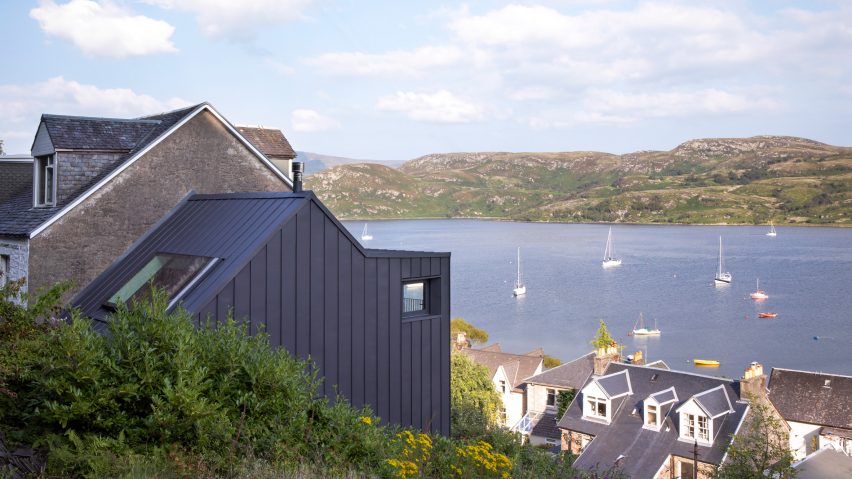Architecture studio Technique has combined a pair of flats adjoining a traditional stone house in Scotland to create The Den, a one-bedroom dwelling clad in a black-metal "jacket".
The Den occupies a hillside site in the village of Tighnabruaich, with a panoramic outlook over a narrow sea channel known as the Kyles of Bute.
Glasgow studio Technique was tasked with connecting two small flats on different levels to create a dwelling and studio with a footprint of 90 square metres.
The studio collaborated on the project with clients Paul Stallan of Stallan-Brand Architects and his wife Seonaid, whose family had owned the attic flat since the 1960s.
The two flats were contained in a small cottage adjoining a larger house built in the 1870s. When Seonaid was offered an opportunity to purchase the lower property, it led to the idea of uniting both flats to create a single and more practical residence.
During the process of opening up the dilapidated spaces, the original stone walls and structural timbers were exposed. This informed a project focused on preservation and playful modernisation.
"A rich palette of materials which had aged over time was revealed, creating unique spatial qualities," said the studio's founder Jamie Ross.
"The clients' ambition to retain this character and atmosphere formed a core part of the new design."
While repairs were made to The Den's existing stonework, much of its timber floor joists, lintels and roof structure had to be replaced.
The rotten timber elements were swapped with concrete and steel, and a new roof was added, providing an opportunity to introduce openings with improved views of the surroundings.
Technique also overcladded the existing building with a new weatherproof shell. An external timber frame, insulation and a weathertight metal cladding form what the studio described as an external "jacket", which allowed the original stonework to be exposed internally.
The Den's steel cladding has a textured powder-coated finish to help it withstand the harsh marine climate and creates a bold contrast with the village's Victorian architecture.
"The juxtaposition of old and new, a uniquely sculptural form and expert craftsmanship combine to create a unique contemporary home reflecting the clients' creativity and personalities," Ross added.
A bifold door with a Juliette balcony and window seat was introduced on the south-facing side of the original attic flat, while a frameless roof light facing north looks onto the woodland canopy behind the dwelling.
Internally, the architects created open-plan living spaces that feel bright and generous, despite the compact footprint.
"To achieve this, we thought of the stairs, kitchen, bathroom and storage as pieces of furniture within a larger space rather than as individual rooms," Ross explained.
"These were designed into a sculptural plywood volume winding between all three storeys and revolving around the kitchen."
The Den's plywood elements extend up from the en-suite bedroom on the lower-ground floor, to the upper-ground floor where the kitchen, dining area and lounge are situated, before culminating in the mezzanine studio and living space.
Birch plywood creates a contemporary contrast to the repaired stone walls and old floorboards, with other materials including modern grey brick contributing to a rich and layered palette.
The new steel elements are left exposed and clearly distinguished from the original structure by their red oxide-painted finish, which is also used on the handrail.
On the mezzanine level, new grey brick abuts the rough stone of the original gable, emphasising the contrast between old and new.
The Den is one of 20 homes longlisted to win RIBA's House of the Year for 2022.
Elsewhere in the Scottish Highlands, Loader Monteith recently extended a remote stone cottage using locally-sourced black timber while Mary Arnold-Foster Architects used planks of burnt larch to clad a cross-laminated timber home in a small Scottish village.
The photography is by Dapple Photography.

